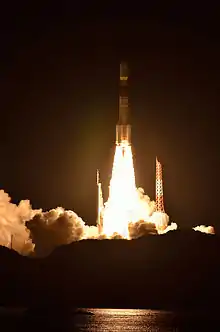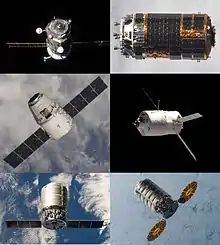 HTV-4 being grappled by the SSRMS on 9 August 2013 | |
| Mission type | ISS resupply |
|---|---|
| Operator | JAXA |
| COSPAR ID | 2013-040A |
| SATCAT no. | 39221 |
| Mission duration | 35 days |
| Spacecraft properties | |
| Spacecraft type | H-II Transfer Vehicle (HTV) |
| Manufacturer | Mitsubishi Heavy Industries (MHI) |
| Launch mass | 15900 kg |
| Dry mass | 10500 kg |
| Start of mission | |
| Launch date | 3 August 2013, 19:48:46 UTC |
| Rocket | H-IIB No. 4 |
| Launch site | Tanegashima, Yoshinobu-2 |
| Contractor | Mitsubishi Heavy Industries |
| End of mission | |
| Disposal | Deorbited |
| Decay date | 7 September 2013, 06:37 UTC |
| Orbital parameters | |
| Reference system | Geocentric orbit[1] |
| Regime | Low Earth orbit |
| Inclination | 51.66° |
| Berthing at ISS | |
| Berthing port | Harmony |
| RMS capture | 9 August 2013, 11:22 UTC |
| Berthing date | 9 August 2013, 15:28 UTC |
| Unberthing date | 4 September 2013, 12:07 UTC |
| RMS release | 4 September 2013, 16:20 UTC |
| Time berthed | 25 days, 20 hours, 29 minutes |
| Cargo | |
| Mass | 5400 kg |
| Pressurised | 3900 kg |
| Unpressurised | 1500 kg |
Kounotori 4, also known as HTV-4, was the fourth flight of the H-II Transfer Vehicle, an uncrewed cargo spacecraft launched in August 2013 to resupply the International Space Station. It launched from Tanegashima Space Center aboard H-IIB No. 4 (H-IIB F4) rocket on 3 August 2013 and connected to ISS by 9 August 2013; it carried 5,400 kilograms (11,900 lb) of cargo.[2] Kounotori 4 undocked on 4 September 2013 and was destroyed by reentry on 7 September 2013.[3][4]
Specifications
Major changes of Kounotori 4 from previous HTV are:
- Although the previous Kounotori 3 used reaction control system (RCS) thrusters by IHI Aerospace, Kounotori 4 uses the RCS manufactured by Aerojet, similar to HTV-1 and Kounotori 2. This will be the last Kounotori to use Aerojet parts, and future Kounotori are to use IHI's.
- One of the solar panels was replaced with a sensor module to measure the surface electrical potential when berthing to ISS.[5]
- Continued improvement of ground operation to allow more late access cargo.
- First time for Kounotori to reenter the atmosphere with unpressurized waste cargo (a NASA engineering experiment module STP-H3).
- The orbital trajectory after departure from ISS is adjusted so that the reentry is to coincide with ISS passing over, to allow the atmospheric entry to be observed from ISS.
Cargo
Kounotori 4 carries about 5,400 kilograms (11,900 lb) of cargo, consisting of 3,900 kilograms (8,600 lb) in the pressurized compartment and 1,500 kilograms (3,300 lb) in the unpressurized compartment.
Pressurized cargo include: CANA (Cabin network system for Kibō), Stirling-Cycle Refrigerator (FROST), ISS Cryogenic Experiment Storage Box (ICE Box), i-Ball and Re-Entry Data Recorder (REDR), four CubeSats: (PicoDragon, ArduSat-1, ArduSat-X, TechEdSat-3p), and the Kirobo (robot companion for Koichi Wakata).
Unpressurized cargo include: MBSU (Main Bus Switching Units) and UTA (Utility Transfer Assembly) which are ISS system spare parts, and a NASA experiment module STP-H4 (Space Test Program - Houston 4).
Operation
Launch and rendezvous with ISS

Kounotori 4 was successfully launched atop a H-IIB carrier rocket flying from pad 2 of the Yoshinobu Launch Complex at Tanegashima Space Center at 19:48:46 UTC on 3 August 2013. After 5.5 days of orbital manoeuvres, it arrived to Approach Initiation Point (5 kilometres (3.1 mi) behind ISS) at 05:31 UTC, 9 August 2013,[6] and started the final approach sequence at 08:05 UTC.[7] The ISS's robotic arm Canadarm2 grappled Kounotori 4 at 11:22 UTC, and fastened to ISS's Common berthing mechanism (CBM) on 16:32 UTC. All berthing operations were completed at 18:38 UTC.[8]
Operation while berthed to ISS
The ISS crew opened the hatch and entered to Pressurized Logistics Carrier (PLC) at 11:11 UTC, 10 August 2013.[9]
Departure from ISS and reentry to Earth atmosphere
Kounotori 4 undocked from the ISS at 16:20 UTC, on 4 September 2013, Karen Nyberg then used the stations Canadarm2 to manoeuvre HTV-4 away from the International Space Station.[3]
Trajectory after the release was controlled so that the reentry coincides with ISS passing over to observe it. Japanese flight controllers have deorbited HTV-4 on 06:11 UTC, on 7 September 2013, and it reentered to the atmosphere around 06:37 UTC, on7 September 2013.[4]
Notes
- ↑ McDowell, Jonathan. "Satellite Catalog". Jonathan's Space Page. Retrieved 9 November 2013.
- ↑ NASA - Japanese Cargo Craft Captured, Berthed to Station (2013)
 This article incorporates text from this source, which is in the public domain.
This article incorporates text from this source, which is in the public domain. - 1 2 "Station Releases a White Stork and Awaits a Swan". NASA. 4 September 2013. Retrieved 4 September 2013.
 This article incorporates text from this source, which is in the public domain.
This article incorporates text from this source, which is in the public domain. - 1 2 "Successful re-entry of H-II Transfer Vehicle "KOUNOTORI 4" (HTV-4)". JAXA. 7 September 2013. Archived from the original on 15 September 2013. Retrieved 1 December 2013.
- ↑ "Features of HTV4". Retrieved 29 July 2013.
- ↑ "KOUNOTORI4 Reaches 5km behind the ISS". JAXA. 9 August 2013. Retrieved 15 August 2013.
- ↑ "KOUNOTORI4 Resumes Approach to the ISS". JAXA. Retrieved 15 August 2013.
- ↑ "ISS Crew Completed KOUNOTORI4 Berthing Operation". JAXA. 10 August 2013. Retrieved 15 August 2013.
- ↑ JAXA (12 August 2013). "ISS Crew Entered KOUNOTORI4 Pressurized Logistics Carrier (PLC). Transfer of the Exposed Pallet (EP) was Completed". Retrieved 15 August 2013.
References
- "HTV4 (KOUNOTORI 4) Mission Press Kit" (PDF). JAXA. 2 August 2013. Retrieved 21 June 2015.
External links
- HTV4 (Kounotori 4) Official page (JAXA)
- 「こうのとり」4号機打ち上げ(ダイジェスト映像) on YouTube (JAXA channel)
- "KOUNOTORI 4" (HTV4) MISSION DIGEST on YouTube (JAXA channel)
- H-II Transfer Vehicle, "KOUNOTORI" 4 (HTV-4) voyages on a new path. on YouTube (JAXA channel)
- HTV-4 Mission Updates, Spaceflight101.com
